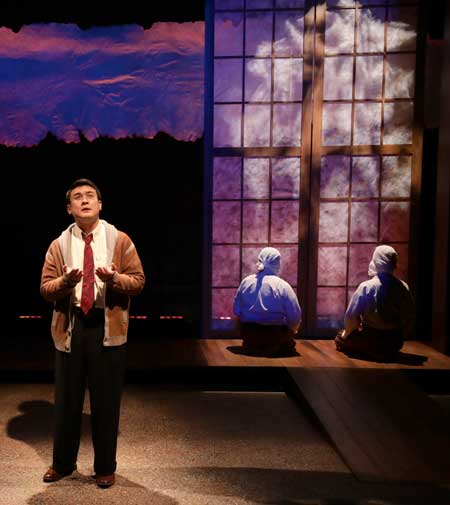Play
by Jeanne Sakata
Directed by Benny Sato Ambush
Scenic Design: Shelley Barish; Lighting Design: Karen Perlow; Sound Design and Original Music: Arshan Gailus; Projection Design: Johnathan Carr
Lyric Stage Company of Boston
Copley Square area, Boston
December 1-31, 2017
With Michael Hisamoto (Gordon Hirabayashi), Khloe Alice Lin (kurogo), Bary Thomas Ng (kurogo), Samantha Richert (kurogo)

with kurogos
in “Hold These Truths”
Photo: Mark S. Howard
Courtesy of Lyric Stage Company of Boston
Based on the actual life story of Gordon Hirabayashi (Michael Hisamoto), this dominantly one-person show gives a detailed, poignant and heart-rending account of a man who refused to go to an internment camp for Japanese-Americans during World War II, was imprisoned for doing so, and who fought in court for exoneration.
Told by a single actor with the support of three silent support actors or kurogos (Khloe Alice Lin, Gary Thomas Ng, Samantha Richert), who gesture and mime in accompaniment, the account is detailed, chronological and delivers a rich account of the series of actions taken by Hirabayashi and the consequences he faced.
Woven within the comprehensive description of the events is Hirabayashi’s untrammeled optimism and deep belief in American values. The title of the play, Hold These Truths, is taken from the preamble to the Declaration of Independence, a document to which Hirabayashi holds fiercely and which represents, despite his strong opposition to the selective isolation of Japanese-Americans, his continuing fervent belief in American values.
Hirabayashi recalls a Japanese saying told to him by his father – the nail that sticks out get hammered – as one of the cultural principles against out of which he has to rise up, as an individual, to defy the American order that Japanese-Americans be interned in camps. As Hirabayashi notes, no German-Americans were so interned during the war, making for a selective isolation of Japanese-Americans a particular insult.
The series of court encounters that follows Hirabayashi’s refusal to enter the internment camp and his subsequent arrest are sometimes daunting, especially in the case of a jury trial in which the judge instructs the jury to find Hirabayashi guilty.
Throughout, Hirabayashi’s serious determination to defend his innocence is conveyed along with a generous sense of fun and good humor. This is a tale of sincerity and belief but without a sense of self-righteousness. I seek to live as though what ought to be is says Hirabayashi near the end of the play, and the simplicity and honor with which that stance is declared reflects the dignity that surrounds his tale.
Michael Hisamoto’s portrayal of Hirabayashi is touched by humor in a lovely way, the character’s sense of forthrightness embodied with a vulnerable and humane disposition.
The three supporting characters perform their Noh-like embellishments with graceful mannerisms, subtly evoking images from Hirabayashi’s monologue evocatively.
Shelley Barish’s design of the production is elegant, with a series of shifting screens and projections by Johnathan Carr that enhance but do not overwhelm. Lighting by Karen Perlow is effectively and thoughtfully done. Music composed and designed by Arshan Gailus subtly suffuses the production, its combination of violin, guitar and other carefully selected instruments providing punctuation that creates lyricism, and sometimes ethereality, as needed.
The text of the play is detailed and chronological, which makes for a lot to digest in its hundred minutes without intermission, but Hisamoto carries it off in a manner that relieves the potential burden of a densely packed text; the design of the production gives it a delicacy of shape that enables its body of information to be carried gracefully.
– BADMan
Leave a Reply